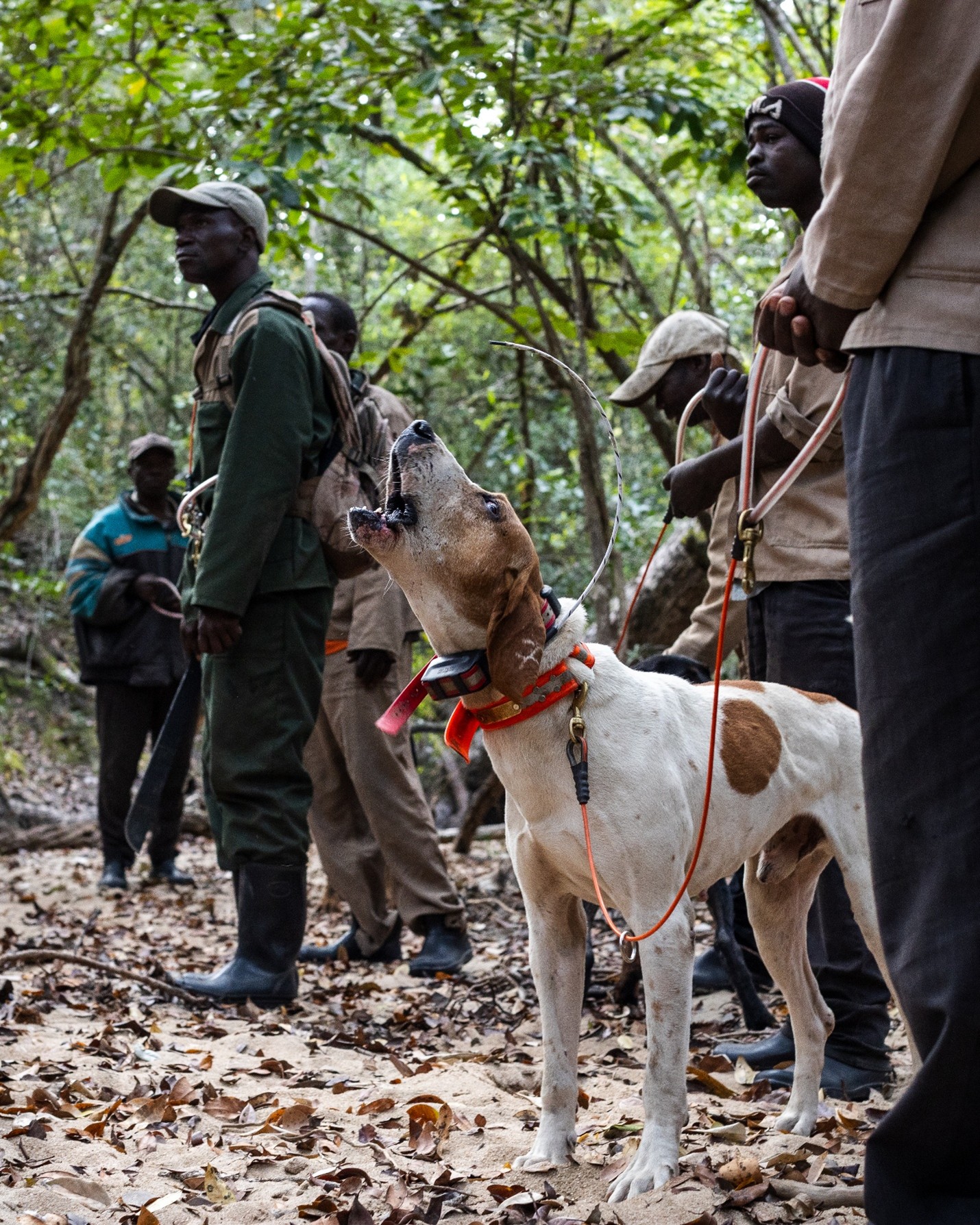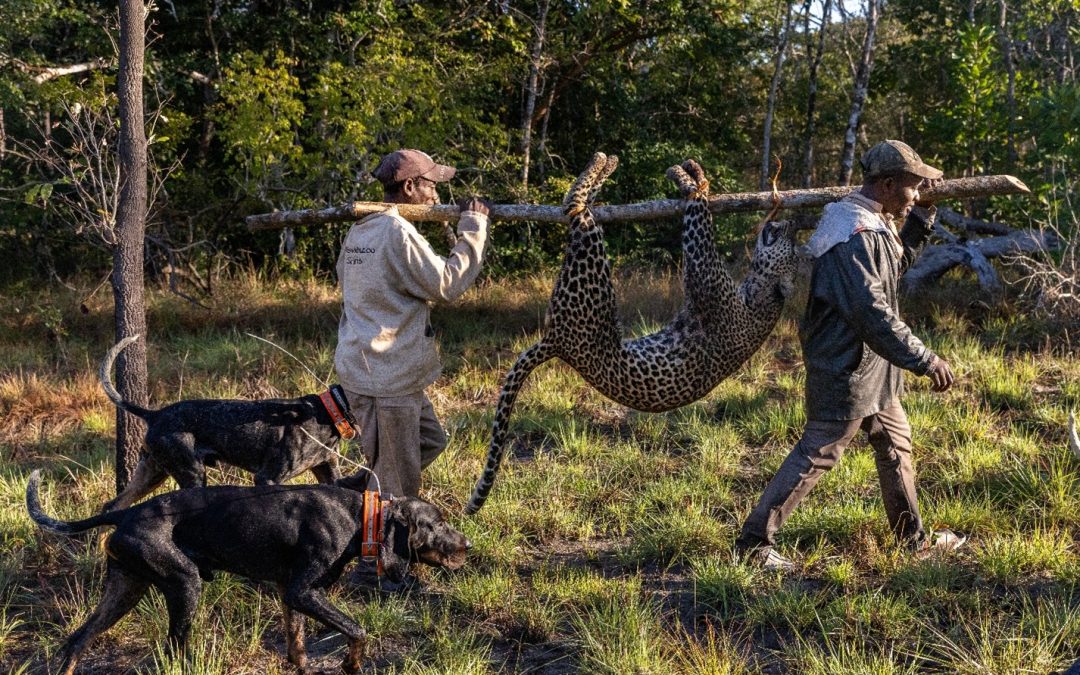Across Zimbabwe, Mozambique, and Botswana, the hound-hunt has matured into one of Africa’s most disciplined and conservation-driven forms of leopard hunting. In this feature, Gavin Lipjes unpacks how the partnership between man and dog refines selectivity, elevates fair chase, and channels substantial funding into anti-poaching and community programs. These countries have proven that when managed correctly, hound-led safaris protect both leopard populations and the vast habitats they inhabit. Yet beyond these borders, much of Africa still hesitates – bound by outdated regulation, political caution, or misplaced perception. In doing so, it forfeits one of the continent’s most effective tools for ethical harvest and rural conservation finance. Beyond the Pursuit challenges that hesitation, arguing that the hound-hunt model should not remain the guarded strength of three nations, but the shared standard of leopard range states across the sub-Saharan frontier.
By Gavin Lipjes | Panther Trackers Global
www.panthertrackers.com
There is a certain silence that overcomes men when the fresh track of a big cat is discovered – a silence heavy with anticipation, stitched together by the rhythm of ‘gearing up’ with the restrained whine of the keen hounds. In that moment, man, dog, and cat are bound in a contest older than language itself.
For many, the notion of hunting a leopard with hounds still raises debate. Yet across much of Southern Africa, that argument has already been settled – not in theory, but in the forests, kopjes and velds of the miombo, mopane and savanna.
In Zimbabwe, Mozambique, and Botswana, the method is proven, legal, and well-regulated. It delivers not only exceptional hunting experiences, but measurable conservation outcomes. The question now isn’t whether hounds belong in leopard hunting. The question is why this model isn’t shared across the whole of the trophy leopard safari range in sub-Saharan Africa…
Proven Model in the Field
In the Lowveld of Zimbabwe, hound-hunting has matured into a disciplined, tightly managed pursuit. Hunts are authorised by Parks, guided by strict quotas, and subject to annual reporting. It is not chaos in the bush; it is structured, selective management.
The results speak for themselves. Mature toms – many past their prime breeding years – are selectively removed. Female leopards are almost never taken. The houndsmen read spoor like scripture: a round pad, wide toe spread, deep impression are some of the unmistakable clues that clearly indicate the difference between a 70 kg tom and a 35 kg female. The hounds are released only when the track fits the target.
The Zimbabwe Parks and Wildlife Management Authority has confirmed that leopard trophy results, including hound hunts, remains non-detrimental to the national population. In practical terms, that means the system works: the offtake is sustainable, the oversight is active, and the revenue supports wildlife protection on the ground.
Across the border in Mozambique, the story echoes. Large concessions in Sofala, Gaza, Tete and Niassa have seen a surge in hound-based safaris. Hunters report consistent take of mature males. Mozambique’s wild blocks, with their open miombo systems, granite kopjes and tall coastal forests, lend themselves perfectly to hound work – vast, rough, and unspoiled.
And then Botswana, where the method is written into law, boasts a vast open Kalahari system, presenting almost boundless country for scent hounds. The government’s system of oversseeing, coupled with the professionalism of licensed operators, has cemented hound-hunting as part of the country’s modern wildlife management framework.
Three countries, three success stories. Each slightly different, yet built on the same foundation: regulated selectivity, fair chase, and tangible conservation return.
“The hound hunt is earned. The leopard has every advantage: stealth, terrain, night vision, and a home range it knows intimately. The dogs only level the field, allowing man to enter the contest where sight fails and scent prevails.”
Selective Harvest and Conservation Impact
Scientific studies from across southern Africa consistently acknowledge the principle of selective off-take, the taking older males has negligible impact on leopard populations and can even mobilise population growth by opening stagnant territories.
Hounds make this possible. By following spoor of broadly identified age and sex individuals, hunters engage generally only the right cats, rendering the hound teams as some of the most selective hunters in the field. This selectivity is not an ethical luxury — it’s a conservation necessity.
Revenue from these hunts sustains some of the largest tracts of leopard habitat on the continent. In Zimbabwe alone, fees from licensed hound packs and leopard tags inject tens of thousands of U.S. dollars annually into the Parks Authority. Those funds pay ranger salaries, fuel anti-poaching units, and contribute to community projects in the CAMPFIRE areas.
Where hound hunting thrives, leopard habitat stays intact. Where it’s banned, those same areas often see rising livestock conflict and unregulated killing. Namibia’s 2009 prohibition on hunting leopards with hounds is a stark example – the hound hunts didn’t stop, they simply went underground, stripping the state of revenue and oversight.
By contrast, Zimbabwe’s transparent, licensed system ensures that every leopard taken by hounds is counted, measured, and reported. The cats remain numerous, and the local communities remain invested.
Why Not the Rest of Leopard range?
Given these successes, it’s time to ask why the hound-hunt model has not been expanded across the leopard’s full range in sub-Saharan Africa.
Zambia, Tanzania and Namibia still rely largely on bait hunting – a method that produces results but lacks the precision and pursuit that hounds offer. The infrastructure exists. The terrain is ideal. The only thing missing is the political will and regulatory adaptation.
Imagine a regional framework: common minimum standards and regulated role players could result in leopard hound hunts that are managed under one ethical code across borders.
– Mature males only and generic trophy reporting.
– Regulated pack sizes.
– Registration of hounds and houndsmen.
– Revenue transparency and community benefit.
This is not a dream. It’s an achievable evolution of what already works in Zimbabwe, Botswana, and Mozambique.
Key Takeaways for Wildlife Managers
- Hound hunting targets specific mature males, reducing population impact.
- Revenue directly supports anti-poaching and community programs.
- Structured regulation maintains transparency and sustainability.
- Banning hounds removes oversight and reduces conservation funding.
The Path Forward
If conservation authorities and hunting associations across Africa are serious about sustainability, then it is time to export the hound-hunt model.
Not as a trend, nor a marketing tool, but as a structured conservation tool.
- Let hound hunts be licensed under transparent, science-based quotas.
- Let outfitters be held to the same standards of reporting and community benefit as Zimbabwe’s model.
- Let the method expand where habitat, governance, and tradition allow.
Because when managed properly, the partnership between man and dog produces something special – a hunt that is both thrilling and defensible.

About the Author
Gavin Lipjes is the founder of Panther Trackers, one of Southern Africa’s leading hound-hunting operations, specialising in leopard over hounds safaris. He is based between South Africa and Mozambique, having conducted hunts throughout the Southern Africa region.
www.panthertrackers.com

